Spatial Heterogeneity of Planning Influencing Factors on Residents’ SWB in Historic Conservation Area of China: Three Cases from Yangzhou
Abstract
1. Introduction
2. Literature Review
2.1. Influencing Factors of SWB
2.1.1. Individual Attribute
2.1.2. Social Support
2.1.3. Living Environment
2.1.4. Macro Background
2.2. Impacts of Heritage Conservation Planning on Residents’ SWB
2.2.1. Positive Impacts
2.2.2. Negative Impacts
3. Methodology
3.1. Study Area and Data Source
3.2. Research Design
3.3. Dependent Variable
3.4. Independent Variable
3.4.1. Physical Planning Measures on City Scale
3.4.2. Physical Planning Measures on Community Scale
3.4.3. Physical Planning Measures on Household Scale
3.5. Control Variable
3.6. Spatial Analysis Method
3.6.1. Kriging Interpolation
3.6.2. Origin-Destination Cost Matrix
3.6.3. Service Area Method
3.6.4. Kernel Density Estimation
3.6.5. Geographical Detector
4. Results
4.1. Spatial Differentiation of Residents’ SWB
4.2. Spatial Pattern of Planning Measures
4.2.1. Overview of Planning Implementation
4.2.2. Physical Planning Measures on the City Scale
4.2.3. Physical Planning Measures on the Community Scale
4.2.4. Physical Planning Measures on the Household Scale
4.3. Spatial Heterogeneous Effects of Planning Measures
4.3.1. Geo-Detector of Key Planning Influencing Factors
4.3.2. Impact Direction of Multi-Dimensional Planning Measures
5. Discussion
5.1. Summary of Findings
5.1.1. Tourism Development: The Paramount Determinant of Residents’ SWB
5.1.2. Common Planning Determinants of Residents’ SWB with Similar Social Impacts
5.1.3. Common Planning Determinants of Residents’ SWB with Different Spatial Effects
5.1.4. Distinctive Planning Influencing Factors of Residents’ SWB
5.2. Planning Suggestions
5.3. Limitations and Prospects
6. Conclusions
- (1)
- The degree of commercialization in historic districts follows an inverted U-shaped relationship with residents’ SWB (SWB). On one hand, excessive commercialization can lead to disruptions in residents’ daily lives due to tourism activities, thereby offsetting the positive social impacts of housing repairs and other social welfare projects. On the other hand, the lack of government guidance and public financial support, with community development entirely driven by residents, makes it difficult to complete infrastructure upgrades in historic districts, leaving residents living in deteriorating housing and outdated facilities. Therefore, maintaining a delicate balance between cultural heritage conservation and reuse, and the improvement of residents’ quality of life, is key to maximizing local residents’ well-being.
- (2)
- Non-physical planning measures, such as community participation and community planning service, may have a greater impact on residents’ SWB than physical measures. This is partly because, within the current cultural heritage conservation system in China, governments, and experts dominate the “elite heritage discourse”. In contrast, the “local heritage discourse” of the vulnerable original residents is weaker. As a result, cultural heritage planning tends to adopt culturally- and economically-driven revitalization strategies, often neglecting the sustainable development of the heritage areas and their surrounding communities. Furthermore, due to the complex ownership of housing in historic districts, projects like housing maintenance require residents and the government to build trust and co-invest.
Author Contributions
Funding
Data Availability Statement
Conflicts of Interest
Appendix A. Sample Overview
| Control Variables | Index Value | Frequency | Ration% | |
| C1 | Gender | male | 144 | 44.7 |
| female | 178 | 55.3 | ||
| C2 | Age | <44 | 19 | 4.7 |
| 45~59 | 97 | 34.8 | ||
| ≥60 | 206 | 64.0 | ||
| C3 | Hukou | local | 300 | 93.2 |
| Non-local | 22 | 6.8 | ||
| C4 | Income level | <2500 | 11 | 3.4 |
| 2500~5000 | 24 | 7.5 | ||
| 5000~10,000 | 239 | 74.2 | ||
| >10,000 | 36 | 11.2 | ||
| C5 | Education level | illiterate | 30 | 9.3 |
| Compulsory school | 46 | 14.3 | ||
| High school | 111 | 34.5 | ||
| Collage and above | 93 | 28.9 | ||
| C6 | Family structure | individual | 64 | 19.9 |
| Conjugal family | 103 | 32 | ||
| Core family | 73 | 22.7 | ||
| Other family structure | 27 | 8.4 | ||
| C8 | Length of residence | <3 years | 13 | 4.0 |
| 3~10 years | 20 | 6.2 | ||
| 10~40 years | 94 | 29.2 | ||
| >40 years | 195 | 60.6 | ||
| C9 | Housing property rights | Private | 171 | 53.1 |
| Public rental | 130 | 40.4 | ||
| Ordinary rental | 21 | 6.5 | ||
| C10 | Housing area | <30 m2 | 36 | 11.2 |
| 30~60 m2 | 110 | 34.2 | ||
| 60~90 m2 | 88 | 27.3 | ||
| 90~120 m2 | 61 | 18.9 | ||
| >120 m2 | 27 | 8.4 |
References
- Zhao, Z.; Lan, W. Formation and Evolution of the Concepts of Historic and Cultural City Protection System. City Plan. Rev. 2022, 46, 20–26. (In Chinese) [Google Scholar]
- Li, S.; Aoki, N.; Wang, R.; Xu, S. Development of Cultural Heritage Conservation Planning in China. Plan. Perspect. 2024, 39, 925–943. [Google Scholar] [CrossRef]
- Zhang, H.; Wang, F.; Guo, F.; Cai, J.; Dong, J. Urban Built Heritage Protection and Realistic Dilemmas: The Development Process, Protection System, and Critical Thinking of Historic Districts in Dalian. Built Herit. 2023, 7, 25. [Google Scholar] [CrossRef]
- Wang, S.; Shi, N.; Zhang, S.; Li, J.; Huo, X.; Ren, Y.; Yang, Y.; Wang, J.; Zhang, G.; Duan, D.; et al. Urban-Rural Planning and Construction and Cultural Inheritance. City Plan. Rev. 2020, 44, 105–111. (In Chinese) [Google Scholar]
- Pennington, A.; Corcoran, R. The Impact of Historic Places and Assets on Community Wellbeing—A Scoping Review. Technical Report. 2019. Available online: https://livrepository.liverpool.ac.uk/id/eprint/3034624 (accessed on 24 November 2024).
- Sheng, G.; Liao, L.; Xiong, L.; Zhu, B.; Cheung, S.M. Revitalization and Development Strategies of Fostering Urban Cultural Heritage Villages: A Quantitative Analysis Integrating Expert and Local Resident Opinions. Systems 2022, 10, 202. [Google Scholar] [CrossRef]
- Zhang, X.; Edelenbos, J.; Gianoli, A. Balancing Urban Conservation and (Re)Development: Tracing Policy Layering in the Mainland of China (1906–2023). Policy Stud. 2024, 45, 1–21. [Google Scholar] [CrossRef]
- Thompson, J.; Wijesuriya, G. From ‘Sustaining Heritage’ to ‘Heritage Sustaining Broader Societal Wellbeing and Benefits’: An ICCROM Perspective. In World Heritage and Sustainable Development, 1st ed.; Routledge: London, UK, 2018; pp. 180–195. [Google Scholar]
- Li, J.; Krishnamurthy, S.; Roders, A.P.; Wesemael, P.V. Community Participation in Cultural Heritage Management: A Systematic Literature Review Comparing Chinese and International Practices. Cities 2020, 96, 102476. [Google Scholar] [CrossRef]
- Cocozza, S.; Sacco, P.L.; Matarese, G.; Maffulli, G.D.; Maffulli, N.; Tramontano, D. Participation to Leisure Activities and Well-Being in a Group of Residents of Naples, Italy: The Role of Resilience. Int. J. Environ. Res. Public Health 2020, 17, 1895. [Google Scholar] [CrossRef] [PubMed]
- Li, J.; Guo, B.; Li, Y.; Hu, X.; Ma, L.; Qi, R. The Impact of Social Network Embeddedness, TPB, and Danwei System on Residents’ Participation Intention in Old Neighborhood Regeneration. Sci. Rep. 2024, 14, 18920. [Google Scholar] [CrossRef] [PubMed]
- Li, J.; Pan, L.; Hu, Y. Cultural Involvement and Attitudes Toward Tourism: Examining Serial Mediation Effects of Residents’ Spiritual Wellbeing and Place Attachment. J. Destin. Mark. Manag. 2021, 20, 100601. [Google Scholar] [CrossRef]
- Cheng, L.; Xu, J. Benefit-Sharing and Residents’ Subjective Well-Being in Rural Tourism: An Asymmetric Approach. J. Destin. Mark. Manag. 2021, 21, 100631. [Google Scholar] [CrossRef]
- Chen, Y.; Cottam, E.; Lin, Z. The Effect of Resident-Tourist Value Co-Creation on Residents’ Well-Being. J. Hosp. Tour. Manag. 2020, 44, 30–37. [Google Scholar] [CrossRef]
- Hu, Y.; Morales, E. The Unintended Consequences of a Culture-Led Regeneration Project in Beijing, China. J. Am. Plan. Assoc. 2016, 82, 148–151. [Google Scholar] [CrossRef]
- Brooks, C.; Waterton, E.; Saul, H.; Renzaho, A. Exploring the Relationships Between Heritage Tourism, Sustainable Community Development, and Host Communities’ Health and Wellbeing: A Systematic Review. PLoS ONE 2023, 18, e0282319. [Google Scholar] [CrossRef] [PubMed]
- Fotiadis, A.; Nuryyev, G.; Achyldurdyyeva, J.; Spyridou, A. The Impact of EU Sponsorship, Size, and Geographic Characteristics on Rural Tourism Development. Sustainability 2019, 11, 2375. [Google Scholar] [CrossRef]
- Hua, W.; Weifeng, S. Tourism-Driven Rural Gentrification: Case Study of Two Villages in Danxia Mount. Tourism Trib. 2021, 36, 69–80. (In Chinese) [Google Scholar]
- Bin, L.; Chun, W. Social Assessment on Performance of Urban Design in Sustainable Urban Regeneration of Historic District: Practicing Open-Style Urban Design in Nanluoguxiang Area of Beijing. City Plan. Rev. 2013, 37, 31–38. (In Chinese) [Google Scholar]
- Yung, E.H.K.; Zhang, Q.; Chan, E.H. Underlying Social Factors for Evaluating Heritage Conservation in Urban Renewal Districts. Habitat Int. 2017, 66, 135–148. [Google Scholar] [CrossRef]
- Fisher, J.; Allen, S.; Yetman, G.; Pistolesi, L. Assessing the Influence of Landscape Conservation and Protected Areas on Social Wellbeing Using Random Forest Machine Learning. Sci. Rep. 2024, 14, 11357. [Google Scholar] [CrossRef] [PubMed]
- Huang, W.; Su, S.; Sun, X. Social Cognition, Socioeconomic Status and Subjective Well-Being of Chinese Migrant Workers. Sci. Rep. 2024, 14, 6550. [Google Scholar] [CrossRef] [PubMed]
- Das, K.V.; Jones-Harrell, C.; Fan, Y.; Ramaswami, A.; Orlove, B.; Botchwey, N. Understanding Subjective Well-Being: Perspectives from Psychology and Public Health. Public Health Rev. 2020, 41, 25. [Google Scholar] [CrossRef] [PubMed]
- Hoogerbrugge, M.; Burger, M. Selective Migration and Urban–Rural Differences in Subjective Well-Being: Evidence from the United Kingdom. Urban Stud. 2021, 59, 2092–2109. [Google Scholar] [CrossRef]
- Phelps, C.; Harris, M.N.; Rowley, S.; Viforj, R.O.; Wood, G.A. Geographic Reference Income and the Subjective Wellbeing of Australians. J. Happiness Stud. 2023, 24, 2855–2880. [Google Scholar] [CrossRef]
- Eibich, P.; Krekel, C.; Demuth, I.; Wagner, G.G. Associations Between Neighborhood Characteristics, Well-Being and Health Vary Over the Life Course. Gerontology 2016, 62, 362–370. [Google Scholar] [CrossRef] [PubMed]
- Chi, C.G.; Cai, R.; Li, Y. Factors Influencing Residents’ Subjective Well-Being at World Heritage Sites. Tourism Manag. 2017, 63, 209–222. [Google Scholar] [CrossRef]
- Mao, Y.; Chen, J.; Liu, X.; Dang, J.; Schiöth, H.B. Social Support Predicted Subsequent Subjective Well-Being During the COVID-19 Pandemic: A Prospective Study. BMC Public Health 2024, 24, 943. [Google Scholar] [CrossRef] [PubMed]
- Mouratidis, K. Built Environment and Social Well-Being: How Does Urban Form Affect Social Life and Personal Relationships? Cities 2018, 74, 7–20. [Google Scholar] [CrossRef]
- Mouratidis, K. Urban Planning and Quality of Life: A Review of Pathways Linking the Built Environment to Subjective Well-Being. Cities 2021, 115, 103229. [Google Scholar] [CrossRef]
- Viforj, R.O.; Suenaga, H.; Brierty, R. Homeownership and Subjective Well-Being: Are the Links Heterogeneous Across Location, Age and Income? Urban Stud. 2023, 61, 859–877. [Google Scholar] [CrossRef]
- Conigliaro, P. Subjective Well-Being in Italian Regions. Soc. Indic. Res. 2020, 161, 751–781. [Google Scholar] [CrossRef]
- Li, X.; Xu, L.; Tian, S.; Yang, J.; Liu, M.; Liu, H. Human Settlements in China Based on the Geographical Scale. Sci. Geogr. Sin. 2022, 42, 951–962. (In Chinese) [Google Scholar]
- Perucca, G. Residents’ Satisfaction with Cultural City Life: Evidence from EU Cities. Appl. Res. Qual. Life 2019, 14, 461–478. [Google Scholar] [CrossRef]
- Ahn, Y.J. Do Informal Social Ties and Local Festival Participation Relate to Subjective Well-Being? Int. J. Environ. Res. Public Health 2020, 18, 16. [Google Scholar] [CrossRef] [PubMed]
- Lindberg, K.; Wolsko, C. Assessing Well-Being Factors in a Growing Community: A Multi-Attribute Vignette Approach. Soc. Indic. Res. 2018, 144, 315–335. [Google Scholar] [CrossRef]
- Li, L.; Shi, L. Economic Growth and Subjective Well-Being: Analyzing the Formative Mechanism of Easterlin Paradox. J. Chin. Sociol. 2019, 6, 1. [Google Scholar] [CrossRef]
- Li, Y.; Zhu, D.; Wang, H. Choice of New Public Service-Oriented Development Mode of Urban Historic Districts: An Empirical Study of Residents’ Satisfaction in Shanghai City. City Plan. Rev. 2016, 40, 51–60. (In Chinese) [Google Scholar]
- Qin, L. Research on Comprehensive Layout Optimization of Municipal Pipelines in a Narrow Space. City Plan. Rev. 2018, 42, 105–110. (In Chinese) [Google Scholar]
- Liang, Z.; Hui, T. Residents’ Quality of Life and Attitudes Toward Tourism Development in China. Tourism Manag. 2016, 57, 56–67. [Google Scholar] [CrossRef]
- Liu, Y.; Shen, L.; Ren, Y.; Zhou, T. Regeneration Towards Suitability: A Decision-Making Framework for Determining Urban Regeneration Mode and Strategies. Habitat Int. 2023, 138, 102870. [Google Scholar] [CrossRef]
- He, S.; Min, Q. Conservation-Compatible Livelihoods in Protected Areas: Concept and the Implementation Approach. J. Nat. Resour. 2023, 38, 862–873. [Google Scholar] [CrossRef]
- Bonfantini, G.B.; Xie, S. Not Only for Tourists: The Historic Urban Landscape as Infrastructure for Livable Contemporary Cities. Urban Plan. Int. 2016, 31, 61–65. (In Chinese) [Google Scholar]
- Jennings, V.; Larson, L.; Yun, J. Advancing Sustainability through Urban Green Space: Cultural Ecosystem Services, Equity, and Social Determinants of Health. Int. J. Environ. Res. Public Health 2016, 13, 196. [Google Scholar] [CrossRef]
- Foroughi, M.; Andrade, B.D.; Roders, A.P.; Wang, T. Public Participation and Consensus-Building in Urban Planning from the Lens of Heritage Planning: A Systematic Literature Review. Cities 2023, 135, 104235. [Google Scholar] [CrossRef]
- Yung, E.H.K.; Sun, Y. Power Relationships and Coalitions in Urban Renewal and Heritage Conservation: The Nga Tsin Wai Village in Hong Kong. Land Use Policy 2020, 99, 104811. [Google Scholar] [CrossRef]
- Gu, Z.; Tian, D. Public Participation in the Conservation and Management of Canal Cultural Heritage Worldwide: A Case Study of the Rideau Canal and Erie Canal. Human. Soc. Sci. Commun. 2024, 11, 1005. [Google Scholar] [CrossRef]
- Harrison, R. Heritage: Critical Approaches, 1st ed.; Routledge: London, UK, 2013. [Google Scholar]
- Qi, R.; Zhou, T.; Dong, W.; Pan, Y.; Qin, Y. A Review on the Research of Public Participation in Urban and Rural Heritage Protection in China in Recent 20 Years. City Plan. Rev. 2021, 45, 105–118. (In Chinese) [Google Scholar]
- Janochka, M.; Sequeira, J. Gentrification in Latin America: Addressing the Politics and Geographies of Displacement. Urban Geogr. 2016, 37, 1175–1194. [Google Scholar] [CrossRef]
- Zhao, Y.; Ponzini, D.; Zhang, R. The Policy Networks of Heritage-Led Development in Chinese Historic Cities: The Case of Xi’an’s Big Wild Goose Pagoda Area. Habitat Int. 2020, 96, 102106. [Google Scholar] [CrossRef]
- Zhao, P.; Ali, Z.M.; Hashim, N.H.N.; Ahmad, Y.; Wang, H. Evaluating Social Sustainability of Urban Regeneration in Historic Urban Areas in China: The Case of Xi’an. J. Environ. Manag. 2024, 370, 122520. [Google Scholar] [CrossRef]
- Li, Y.; Ye, Y.; Xiao, L.; Xu, W.A.; Law, A.M.; Wang, D. Classifying Community Space at a Historic Site through Cognitive Mapping and GPS Tracking: The Case of Gulangyu, China. Urban Des. Int. 2017, 22, 127–149. [Google Scholar] [CrossRef]
- Jiang, Y.; Chen, L.; Xie, Y.; Li, Y.; Li, T. Subjective Well-Being of Historical Neighborhood Residents in Beijing: The Impact on the Residential Environment. Sustainability 2023, 15, 1847. [Google Scholar] [CrossRef]
- Zukin, S.; Kasinitz, P.; Chen, X.M. Global Cities, Local Streets: Everyday Diversity from New York to Shanghai, 1st ed.; Routledge: London, UK, 2016. [Google Scholar] [CrossRef]
- Pinheiro, F. Redesigning Historic Cities Facing Rapid Tourism Growth: The Case of Macao’s World Heritage Centre and San Ma Lou Avenue. Worldw. Hosp. Tour. Themes 2017, 9, 274–288. [Google Scholar] [CrossRef]
- Wu, Y.; Chen, J.; Bian, Z.; Wang, H.; Wang, Z. Housing, Housing Stratification, and Chinese Urban Residents’ Social Satisfaction: Evidence from a National Household Survey. Soc. Indic. Res. 2020, 152, 653–671. [Google Scholar] [CrossRef]
- Su, M.M.; Wall, G.; Xu, K. Tourism-Induced Livelihood Changes at Mount Sanqingshan World Heritage Site, China. Environ. Manag. 2016, 57, 1024–1040. [Google Scholar] [CrossRef] [PubMed]
- Li, L.; Tang, Y. Towards the Contemporary Conservation of Cultural Heritages: An Overview of Their Conservation History. Heritage 2023, 7, 175–192. [Google Scholar] [CrossRef]
- Tweed, C.; Sutherland, M. Built Cultural Heritage and Sustainable Urban Development. Landsc. Urban Plan. 2007, 83, 62–69. [Google Scholar] [CrossRef]
- Tu, X.Y.; Huang, G.L.; Wu, J.G. Review of the Relationship Between Urban Greenspace Accessibility and Human Well-Being. Acta Ecol. Sinica 2019, 39, 421–431. [Google Scholar] [CrossRef]
- Wang, Z. Geostatistics and Its Applications in Ecology, 1st ed.; Science Press: Beijing, China, 1999; pp. 102–110. (In Chinese) [Google Scholar]
- Wu, Y.; Wu, C. Study on Urban Benchmark Land Price Evaluation Based on Kriging Technology. Econ. Geogr. 2001, 21, 584–588. (In Chinese) [Google Scholar]
- Esri. OD Cost Matrix Analysis Layer. ArcGIS Pro Documentation. Available online: https://pro.arcgis.com/en/pro-app/latest/help/analysis/networks/od-cost-matrix-analysis-layer.htm (accessed on 24 November 2024).
- Seaman, D.E.; Powell, R.A. An Evaluation of the Accuracy of Kernel Density Estimators for Home Range Analysis. Ecology 1996, 77, 2075–2085. [Google Scholar] [CrossRef]
- Ouyang, D.; Zhu, X.; Liu, X.; He, R.; Wan, Q. Spatial Differentiation and Driving Factor Analysis of Urban Construction Land Change in County-Level City of Guangxi, China. Land 2021, 10, 691. [Google Scholar] [CrossRef]
- Huang, H.; Zhou, Y.; Qian, M.; Zeng, Z. Land Use Transition and Driving Forces in Chinese Loess Plateau: A Case Study from Pu County, Shanxi Province. Land 2021, 10, 67. [Google Scholar] [CrossRef]
- Wang, J.; Xu, C. Geographical Detector: Principles and Prospects. Acta Geogr. Sin. 2017, 72, 116–134. (In Chinese) [Google Scholar]
- Tokarchuk, O.; Gabriele, R.; Maurer, O. Estimating Tourism Social Carrying Capacity. Ann. Tour. Res. 2021, 86, 102971. [Google Scholar] [CrossRef]
- Su, L.; Yang, X.; Swanson, S.R. The Impact of Spatial-Temporal Variation on Tourist Destination Resident Quality of Life. Tourism Manag. 2022, 93, 104572. [Google Scholar] [CrossRef]
- Xie, Y.; Chen, L.; Jiang, Y.; Zhang, W.; Dou, C. Disparities of Residents’ Subjective Well-Being in the Old City of Beijing: A Comparative Study Between Historic Districts and Non-Historic Districts. Areal Res. Dev. 2022, 41, 70–76. (In Chinese) [Google Scholar]
- Thuc, L.D.; Nguyen, M.V.; Duy, K.H.; Van, D.N. Prioritizing Barriers to the Conservation of Cultural Heritage Buildings in Adaptation to Urbanization and Climate Change. J. Clean. Prod. 2024, 473, 143529. [Google Scholar] [CrossRef]
- Abbott, P.A.; Brooker, R.; Reath, J. Managing the Hope and Worry of Housing Renewal—Supporting Well-Being in the Emerging Community. Health Promot. J. Aust. 2018, 30, 344–349. [Google Scholar] [CrossRef] [PubMed]
- Yu, Y.; Zhang, Y. Satisfaction with Community Public Services, Social Support, and Subjective Well-Being in China. Soc. Behav. Personal. 2023, 51, 11. [Google Scholar] [CrossRef]
- Dong, Y.; Han, D. Types, Processes, and Key Issues of Residential Area Regeneration: A Case Study of Nanjing. City Plan. Rev. 2024, 48, 34–42. (In Chinese) [Google Scholar]
- Ma, Y.; Ma, B.; Yu, L.; Ma, M.; Dong, Y. Perceived Social Fairness and Trust in Government Serially Mediate the Effect of Governance Quality on Subjective Well-Being. Sci. Rep. 2024, 14, 15905. [Google Scholar] [CrossRef]
- Chen, J.; Wang, S.; Wan, L. Does Government Environmental Governance Information Disclosure Improve Residents’ Subjective Well-Being? Evidence from China. J. Environ. Plan. Manag. 2022, 66, 1720–1742. [Google Scholar] [CrossRef]
- Andereck, K.L.; Valentine, K.M.; Knopf, R.C.; Vogt, C.A. Residents’ Perceptions of Community Tourism Impacts. Ann. Tour. Res. 2005, 32, 1056–1064. [Google Scholar] [CrossRef]
- Kang, W.; Guo, H. What Influences the Community Well-Being of Chinese Living in Metropolitan Areas? A Scale Validation and Invariance Test Across Gender, Age, and Hukou. BMC Public Health 2024, 24, 20979. [Google Scholar] [CrossRef] [PubMed]
- Ma, S.; Wang, B.; Liu, W.; Zhou, H.; Wang, Y.; Li, S. Assessment of Street Space Quality and Subjective Well-Being Mismatch and Its Impact, Using Multi-Source Big Data. Cities 2024, 147, 104797. [Google Scholar] [CrossRef]
- Lee, T.H.; Jan, F.H. Can Community-Based Tourism Contribute to Sustainable Development? Evidence from Residents’ Perceptions of the Sustainability. Tourism Manag. 2019, 70, 368–380. [Google Scholar] [CrossRef]
- Li, L.; Gan, Y.; Xie, S. Investigating Resident–Tourist Sharing of Urban Public Recreation Space and Its Influencing Factors. ISPRS Int. J. Geo-Inf. 2024, 13, 305. [Google Scholar] [CrossRef]
- Yang, Y.; Zhao, L.; Cui, F. How Does Public Health Investment Affect Subjective Well-Being? Empirical Evidence from China. Int. J. Environ. Res. Public Health 2022, 19, 5035. [Google Scholar] [CrossRef]
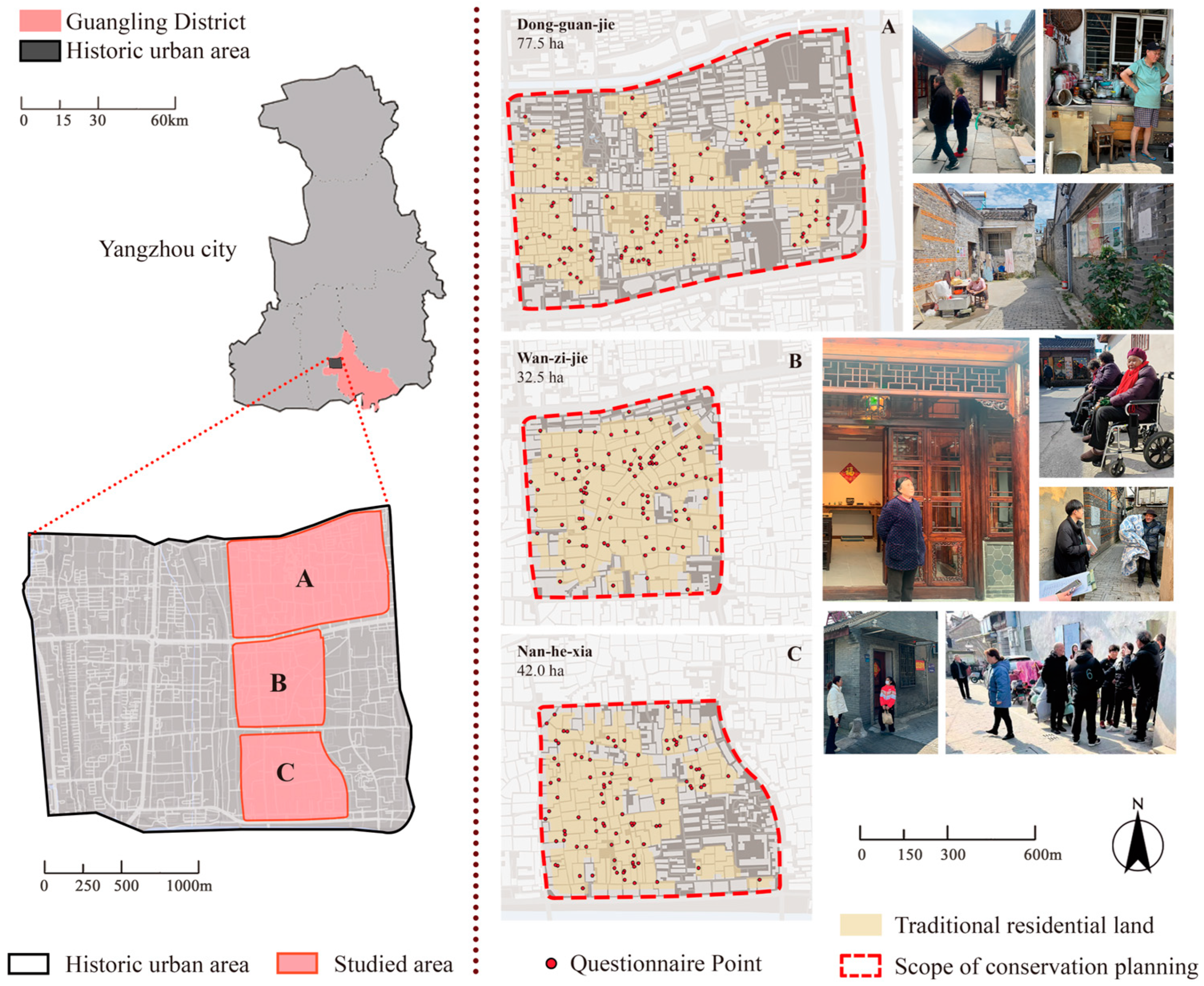
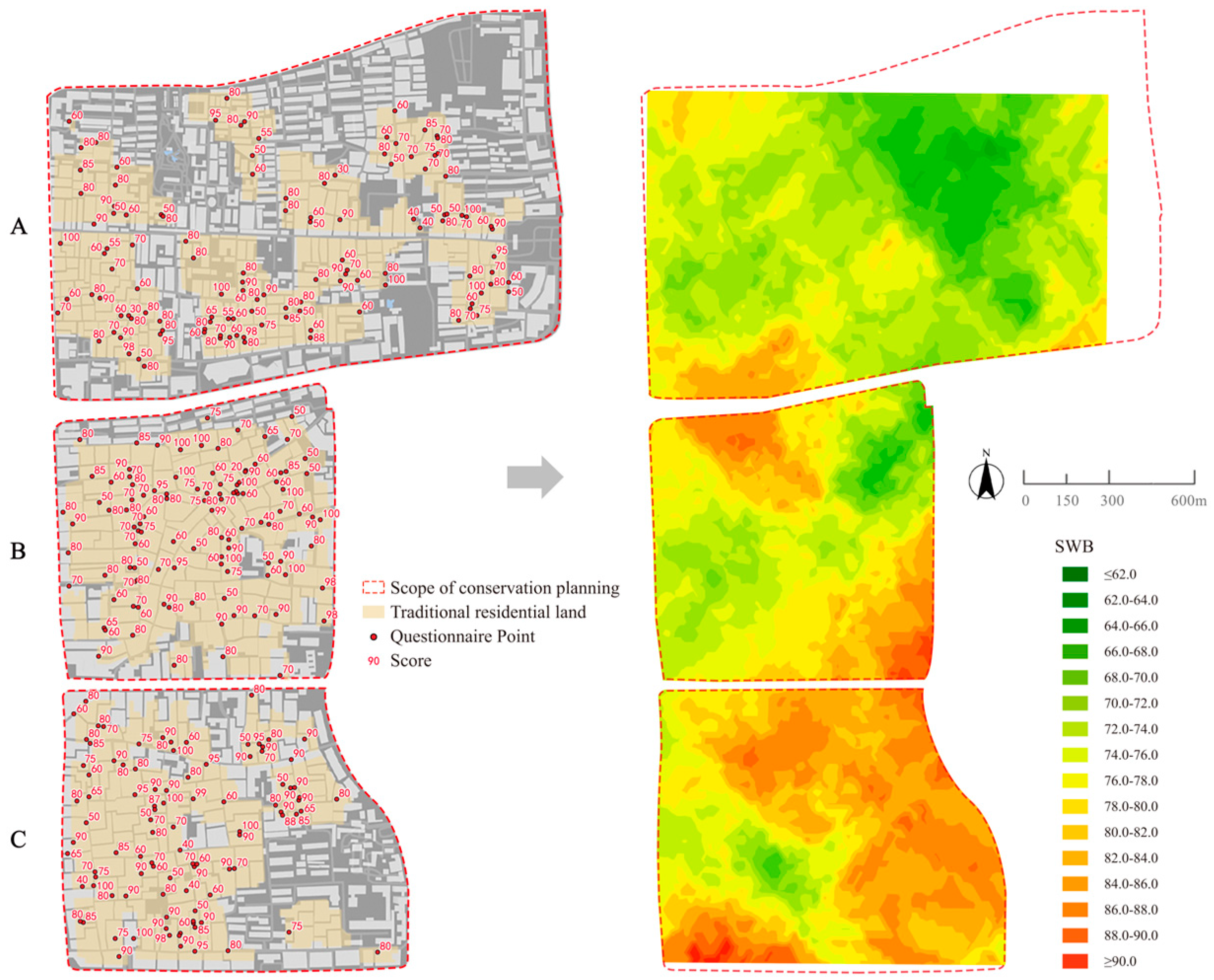
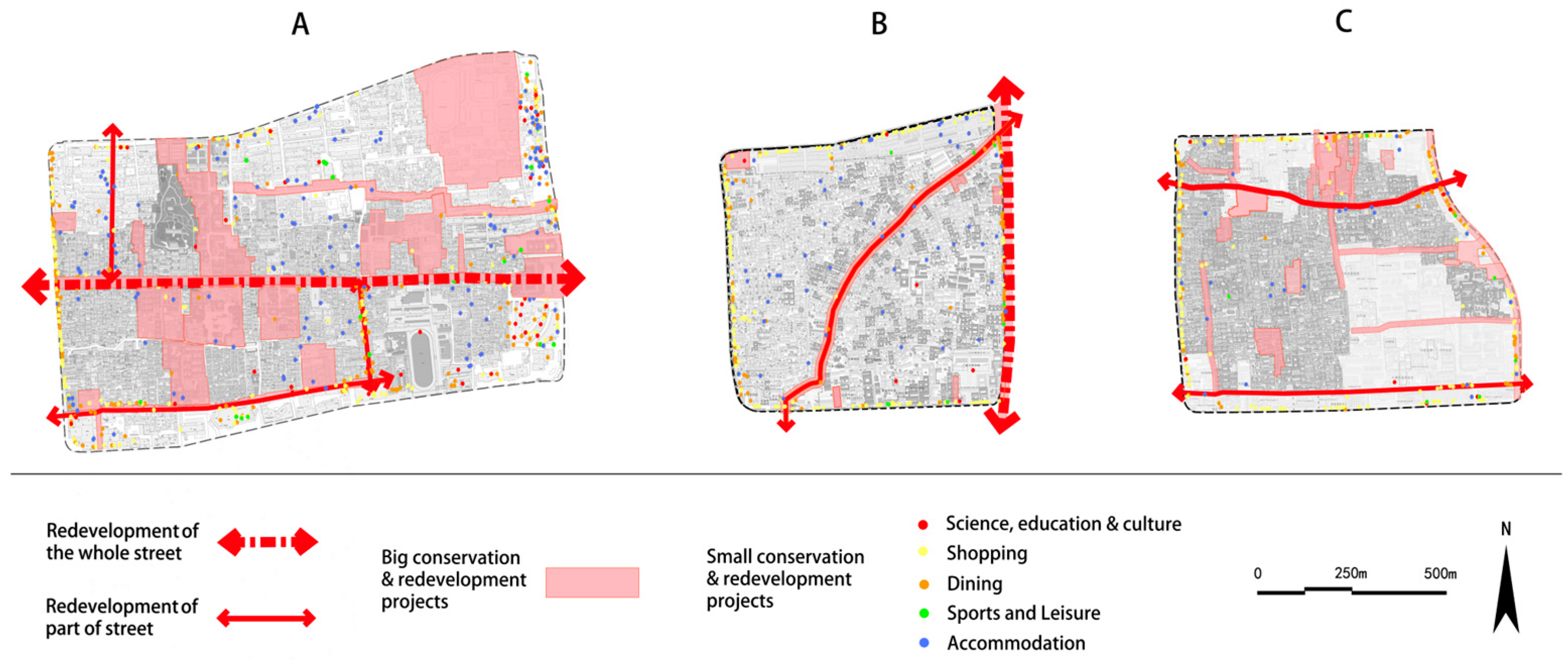
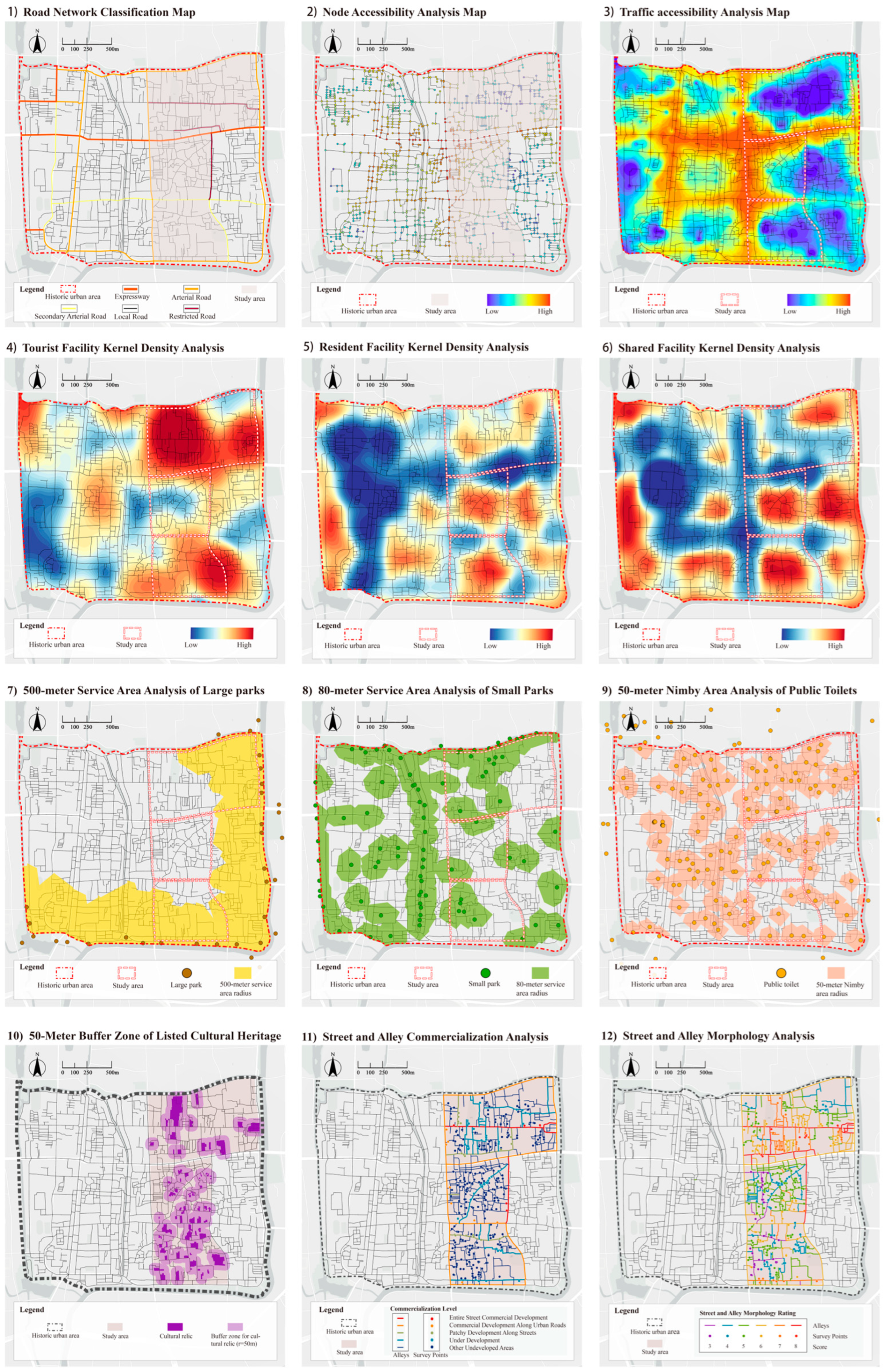
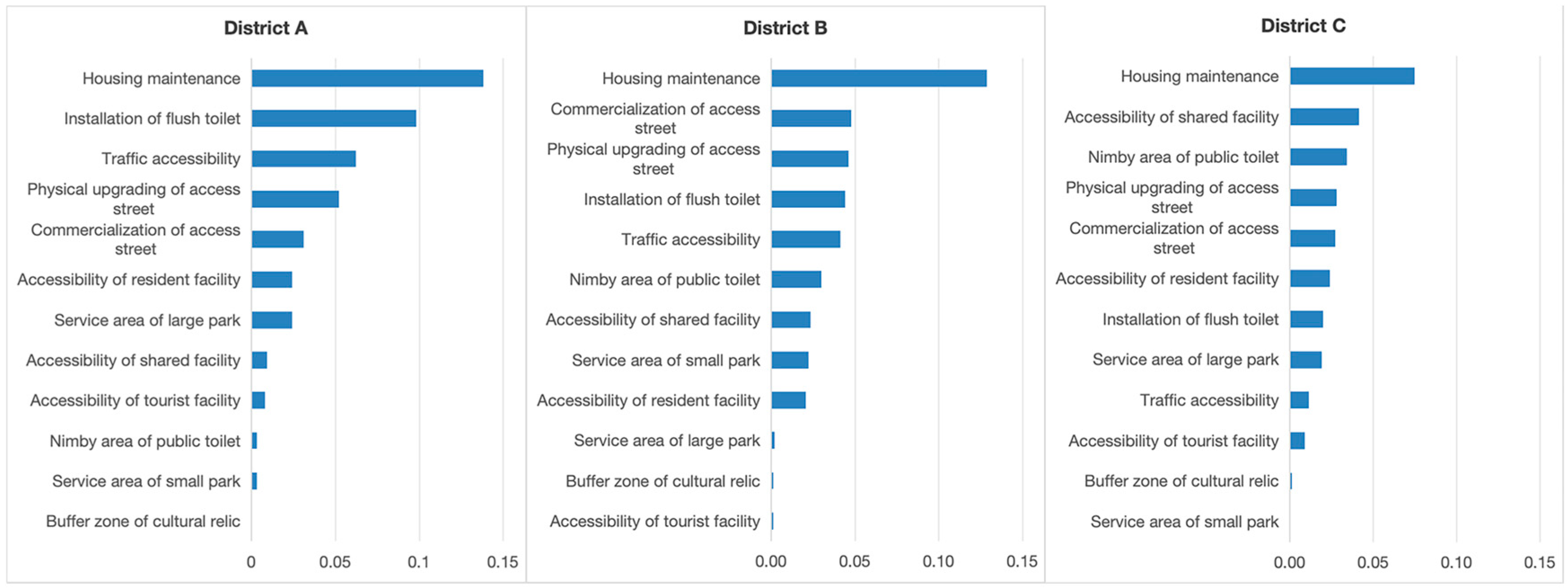
| Categories | Sub-Categories | Variables | Source |
|---|---|---|---|
| Individual Attribute | Demographic information | Gender, age, education level, marital status, income level, number of children; | [22] |
| Health and Personality Traits | Physical and mental health conditions, personality traits; | [23] | |
| Work and Beliefs | Work status, religious beliefs, political orientation; | [22] | |
| Aspirations | Personal aspirations; | [24] | |
| Social Support | Material support | Provided by family members, friends, neighbors, and other affiliated groups; | [23,25,26,27,28] |
| Emotional support | |||
| Living Environment | Physical Environment | Housing conditions, supporting facilities, infrastructure, public facilities, public space, broader ecological conditions, residential location, traffic convenience, accessibility of public facilities and public spaces | [29,30,31,32,33] |
| Non-physical Environment | Social and cultural environment, community service, community participation, community governance, demographic composition, neighborhood effects; | [5,10,13,24,26,34,35] | |
| Macro Background | With significant Influence | Economic development level, cultural environment, employment conditions, national governance, socioeconomic development policies, social welfare; material needs evolving towards enjoyment-oriented demands, social inequality; | [25,36] |
| With non-significant Influence | -- | [37] |
| Planning Measures | Positive Effects | Negative Effects | |
|---|---|---|---|
| Social-led | Physical upgrading; traffic control; increase community service and facilities; improve housing conditions; promote public participation; | Improve community reputation and image; improve living environment and housing conditions; other physical and emotional benefits; | Increase the cost of cultural heritage preservation; Reduce economic efficiency; |
| Economic-led | Tourism development; real estate development; commercialization; | Increase residents’ property values, rent income, job opportunities; increase public income and in turn, increase social investment; increase market-led public service; | Compulsory population relocation; social inequality; traffic congestion; noise disturbance; insecurity; waste pollution; higher living cost; lower living quality; |
| Cultural-led | Preservation of cultural heritage; construction control; reuse of historic buildings, historic gardens, and historic environment elements; | Providing more public facilities and public spaces; enhance community reputation and image; increase residents’ sense of place and cultural identity; | Reduce residents’ investment in housing improvement; reduce locally-based social and economic vitality; |
| Physical Planning Measures | Index | Quantitative Method | Data Source | ||
|---|---|---|---|---|---|
| City scale | Transportation planning | X1 | Traffic accessibility | Origin-Destination Cost Matrix | Official data |
| Public facility planning | X2 | Accessibility of tourist facility | Kernel density analysis | Open-source big data of POI | |
| X3 | Accessibility of resident facility | ||||
| X4 | Accessibility of shared facility | ||||
| Public space planning | X5 | Service area of large park | Service area analysis (0 = out; 1 = in) | Official data | |
| X6 | Service area of small park | ||||
| Sanitation facility planning | X7 | Nimby area of public toilet | Service area analysis (0 = out; 1 = in) | Open-source big data of POI | |
| Community scale | Heritage conservation | X8 | Buffer zone of cultural relic | Service area analysis (0 = out; 1 = in) | Official data |
| Economic development | X9 | Commercialization of access street | Likert scale (coding:1~5) | Official data and expert scoring | |
| Image and infrastructure | X10 | Physical upgrading of access street | Likert scale (coding:1~9) | Official data and expert scoring | |
| Household scale | Housing improvement | X11 | Housing maintenance | Likert scale (coding:1~5) | Questionnaire survey |
| Housing security | X12 | Installation of flush toilet | Categorical scale (0 = no; 1 = yes) | Questionnaire survey | |
| District A | District B | District C | |||
|---|---|---|---|---|---|
| Two-Factor Enhancement | q | Two-Factor Enhancement | q | Two-Factor Enhancement | q |
| X11 ∩ X12 | 0.231 | X9 ∩ X11 | 0.182 | X7 ∩ X11 | 0.128 |
| X1 ∩ X12 | 0.165 | X6 ∩ X11 | 0.167 | X9 ∩ X11 | 0.118 |
| X3 ∩ X12 | 0.125 | X3 ∩ X11 | 0.162 | X8 ∩ X11 | 0.094 |
| X7 ∩ X12 | 0.109 | X5 ∩ X11 | 0.144 | X3 ∩ X7 | 0.069 |
| X8 ∩ X12 | 0.106 | X1 ∩ X10 | 0.106 | X5 ∩ X7 | 0.064 |
| Variables | District A N = 124 | District B N = 103 | District C N = 95 | ||
|---|---|---|---|---|---|
| Control variables | |||||
| Individual attribute | C1 | Gender | −0.105 | 0.023 | 0.050 |
| C2 | Age | −0.046 | −0.158 | 0.089 | |
| C3 | Hukou | −0.180 * | −0.105 | 0.150 | |
| C4 | Income level | 0.188 * | 0.029 | 0.228 * | |
| C5 | Education level | −0.203 * | −0.278 * | 0.047 | |
| Social support | C6 | Family structure | 0.018 | 0.010 | 0.023 |
| C7 | Neighborly relations | 0.067 | 0.201 * | 0.165 | |
| C8 | Length of residence | −0.148 | 0.038 | −0.123 | |
| Inherent living environment | C9 | Housing property rights | 0.227 * | 0.062 | −0.198 |
| C10 | Housing area | 0.349 ** | 0.035 | −0.106 | |
| Non-physical planning measures | |||||
| Community development | W1 | Community planning service | 0.306 *** | 0.140 | 0.243 * |
| W2 | Community participation | 0.268 *** | 0.361 *** | 0.361 *** | |
| Physical planning measures | |||||
| City level | X1 | Traffic accessibility | −0.166 | −0.213 | −0.323 |
| X2 | Accessibility of tourist facility | 0.119 | −0.340 | −0.262 | |
| X3 | Accessibility of resident facility | 0.351 ** | 0.197 | −0.005 | |
| X4 | Accessibility of shared facility | −0.124 | 0.175 | 0.233 | |
| X5 | Service area of large park | −0.208 * | -- | −0.027 | |
| X6 | Service area of small park | −0.172 * | 0.057 | −0.036 | |
| X7 | Nimby area of public toilet | −0.111 | 0.052 | 0.227 * | |
| Community level | X8 | Buffer zone of cultural relic | −0.065 | −0.045 | −0.058 |
| X9 | Commercialization of access street | 0.070 | −0.003 | 0.030 | |
| X10 | Physical upgrading of access street | −0.103 | 0.102 | −0.142 | |
| Household level | X11 | Housing maintenance | 0.181 * | 0.145 | 0.163 |
| X12 | Installation of flush toilet | 0.178 * | 0.119 | 0.177 * | |
Disclaimer/Publisher’s Note: The statements, opinions and data contained in all publications are solely those of the individual author(s) and contributor(s) and not of MDPI and/or the editor(s). MDPI and/or the editor(s) disclaim responsibility for any injury to people or property resulting from any ideas, methods, instructions or products referred to in the content. |
© 2024 by the authors. Licensee MDPI, Basel, Switzerland. This article is an open access article distributed under the terms and conditions of the Creative Commons Attribution (CC BY) license (https://creativecommons.org/licenses/by/4.0/).
Share and Cite
Chen, Y.; Shen, Y.; Wang, C. Spatial Heterogeneity of Planning Influencing Factors on Residents’ SWB in Historic Conservation Area of China: Three Cases from Yangzhou. Land 2025, 14, 29. https://doi.org/10.3390/land14010029
Chen Y, Shen Y, Wang C. Spatial Heterogeneity of Planning Influencing Factors on Residents’ SWB in Historic Conservation Area of China: Three Cases from Yangzhou. Land. 2025; 14(1):29. https://doi.org/10.3390/land14010029
Chicago/Turabian StyleChen, Yue, Yiting Shen, and Can Wang. 2025. "Spatial Heterogeneity of Planning Influencing Factors on Residents’ SWB in Historic Conservation Area of China: Three Cases from Yangzhou" Land 14, no. 1: 29. https://doi.org/10.3390/land14010029
APA StyleChen, Y., Shen, Y., & Wang, C. (2025). Spatial Heterogeneity of Planning Influencing Factors on Residents’ SWB in Historic Conservation Area of China: Three Cases from Yangzhou. Land, 14(1), 29. https://doi.org/10.3390/land14010029





